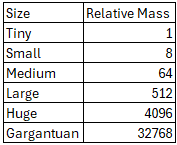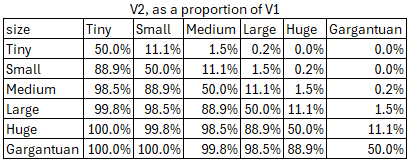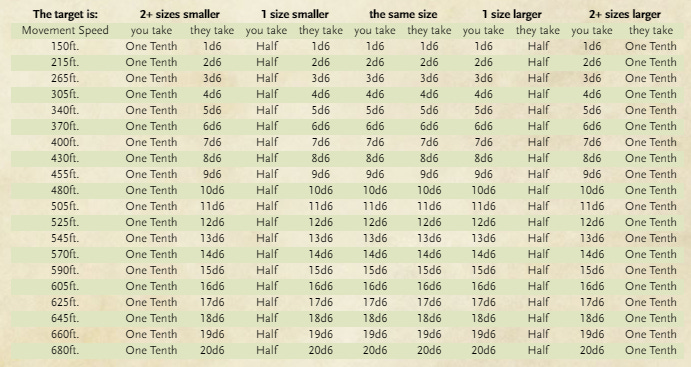Welcome one and all to Training Tuesday 0011! If you don’t like the title, please come forth with suggestions for better ones!
This will form a replacement service for Trinket Tuesdays, and will be a mixture of traps, puzzles, encounters, worldbuilding advice, random tables, and other resources for DMs and GMs to enjoy and use for their games2.
Today I am going to be covering a question which has come up a few times on the internet in my time perusing assorted forums - the subject of running really, really fast.
The general premise of the “make the fastest character ever” approach is to take a Tabaxi character and load as many speed-boosting abilities and effects on them as possible. One of the most effective involves a few specific magic items and allies, but it ultimately achievable as a party:
Tabaxi, monk(13), elk-totem barbarian(5), fighter (2), with a boon of speed, longstrider, 2 artefacts with +20ft. speed, transmuter stone, glory paladin oath aura, and the mobile feat, with boots of speed and a potion of haste.
By using feline agility, moving, dashing, dashing again with haste, step of the wind to dash, and action surge to dash, this build can hit 6,800ft. per round, which is just over Mach 1.
The question then comes in - what happens if you run into somebody whilst moving as fast as a bullet?
Well, doing some work with Physics, I worked out a decent system for it, based off of falling!
The Physics
Falling is dangerous in D&D - not because of the fall, but because of the sudden stop. This is a transfer of energy, and the time it takes for that transfer of energy is what makes the falling creature snap like brittle twigs or spontaneously assume the form of a beached jellyfish.
As Falling is the closest analogy to running into something really fast3, I started by establishing through the SUVAT equations how fast you need to run to match with falling a distance, namely the 3rd equation of motion, v2 = u2 + 2as. We know that U ( the starting velocity of the fall) is 0, so v2 = 2as, where a is the acceleration due to gravity (32'feet per second2) and s is the distance travelled. Thus, we can work out the speed of impact for the poor creature when falling from different heights, assuming no air resistance4.
This makes a table of speeds which looks like this:
This is the limit they have for fall damage in D&D - if you fall over 200ft., it peaks at 20d6. This is, I suspect, an abstract way of conveying terminal velocity. Given that you will have t obe REALLY going some to exceed 680ft. per round, it’s not unreasonable to cap it here.
So now we have the numbers for “if I run into a wall at this speed, what will happen?”, but this is only half the question.
To answer the next part - what happens if I run into someone at this speed - things get a little more complex - you will probably need a calculator to work this all out by the end of it!
The principle I am following is the 1st law of Thermodynamics5, which is that Energy can never be created or destroyed. Given that we’re not going nearly fast enough to transform matter into exciting new forms of energy, this will hold true. In game terms, it means that the energy represented by both the speed of the creature and the damage dice will remain consistent.
In our example with the wall, the wall takes no damage and the person takes all of it. This is because the walls mass is sufficient that the transfer of momentum between the person and the wall causes minimal acceleration on the wall. Like throwing a wet sponge at the back of a car6, the car does not speed up an awful lot, but the sponge does slow down, and very quickly. That’s momentum. If you threw a 14-ton sponge at the back of a car, you’d expect different results.
In D&D, the creatures all have a size category - from Tiny, all the way through Small, Medium, Large, and Huge, up to Gargantuan. The general premise of this is that each size class is twice as large in each dimension as the previous, meaning roughly 8 times more massive7 than the size below. This falls down a little at Tiny and Gargantuan, as they are open-ended - an ant is Tiny, but so is a cat, whilst a dragon is Gargantuan, and so is the dragon that hatches from the moon. This complication is not for me to overly worry about - if it becomes an issue, wing it; that’s the DM’s job.
Back to working it all out.
Given the assumption that creatures are 8x more massive than their smallers and 8x less massive than their largers, we need to make a system to work out the acceleration on them caused by an impact. For this, we use Momentum - which is calculated as Mass x Velocity, or p=mv. Why is it “p”? no idea. But it is.
Momentum is always conserved in elastic collisions8, meaning that the p before = p after. In Elastic collisions, the masses combine on impact - meaning they don’t bounce off each other, they crash into each other and tumble onwards together.
Given that acceleration - the change of speed over time - is what causes damage in an impact9, this is going to be proportional to the damage dice, and to the change in velocity between before and after the impact.
First up, let’s get some relative masses for the creatures. The exact value is irrelevant - all that matters is how many times larger or smaller one creature is than the other.
Immediately, I can see that this isn’t going to work very well with this premise. The Gargantuan one is so much larger than the large ones and smaller, and these are some horrible numbers to work with, meaning nobody in their right minds will use them.
Let’s keep going and see if it simplifies at all at the other end10.
Knowing that momentum before is equal to momentum after, we know that the velocity before (assuming a stationary target) multiplied by the weight of the creature is equal to the velocity of both creatures afterwards, multiplied by the weight of both creatures. We can therefore work out the proportion of the speed:
thus we can get the second velocity (velocity after impact):
where m1 is the mass of the runner and m2 is the mass of the impactee. It’s all so simple and quick to do - but we can make it quicker with a table, methinks, by expressing v2 as a proportion of v111:
So this will output the % of the speed they are now moving after the impact. It’s getting simpler, but will it make any difference with those huge numbers? Let’s have a look!
As I expected, two similar sized creatures crashing into each other will have half the speed after the crash - meaning if you slam into someone at 600ft. per round, you’ll both still be flying at 300ft. per round after the crash. Here’s the summary:
If you hit something a size larger than you, you drop to 11.1%, or 1/9 of your original speed, and if you hit anything larger, you’re basically coming to a stop.
If you hit something the same size as you, your speed halves.
If you hit something a size smaller than you, you lose 1/9 of your speed.
If you hit something 2 sizes or more smaller than you, you basically don’t slow down.
We can use this for some neat simplification - the rules for forcing movement by crashing into something only apply if they are no more than 1 size larger than you. That takes the silly numbers of the Gargantuan creatures out of the equation, but maintains the effects of them.
For the sake of simplicity, 1/9 is close to 1/10, and 1/10 is much easier to calculate, so let’s use that. We’ll also say that this only starts working when you hit 150ft/round, which means it’ll likely increment in 10’s anyway.
Let’s Jargonise it!
There’s no point using physics as game rules - you use physics to make game rules. so let’s turn these calculations into hard rules:
Running Into Things
Running into things at speed is a good way to do yourself damage. However, if you happen to be running into something that you want to cause damage to, it can work both ways.
If you have a movement speed equal to or greater than 150ft. per round, you can use an Action to make a Charge attack against a target creature or object in your path. you must move in a straight line and declare the speed you are moving, move directly to the creature, and then make a Grapple check against them. If a creature is 2 sizes or more smaller than you, then they have advantage on this check, and if they are 2 sizes or more larger than you, then they have disadvantage on this check.
If the target creature successfully evades the grapple, then they dodge out of the way, and you continue in your straight line at the speed you were moving.
If you succeed in your grapple, then the impact will involve an amount of bludgeoning damage equal to the amount shown in the table below, based on the speed you were moving and the size of the target, relative to you. Consult the table to determine how to allocate the damage. If dealing one tenth damage, this rounds down - EG, if you roll 38 damage, the target taking one tenth damage will take 3 points of damage, not 4.
Ramming Speed
When you hit a creature whilst moving at high speed, you can push them at a speed following the impact. This is calculated as your Remaining Movement (EG, if you are moving at 420ft. per round, if you have moved 180ft. to reach them, you have 240ft. of Remaining Movement). In all cases, you move with the target.
If the target is one or more sizes smaller than you, you push them a distance equal to your Remaining Movement.
If the target is the same size as you, you push them half of your Remaining Movement.
If the target is one size larger than you, then you push them one tenth of your Remaining Movement, rounding up to the nearest 5ft.
If the target is two or more sizes larger than you, then your Remaining Movement is reduced to 0ft., and you stop moving.
And there we have it! Lots of calculations, all condensed into one table that allows a character to do some awesome, if tactically questionable, things!
My favourite imagined use for this12 would be for someone to try and take a super-powerful enemy away from their friends in a charge of self-sacrifice, dragging the enemy hundreds of feet away to let them escape.
What would you use this for? Let me know in the comments!
If you enjoy reading my articles, and want to see more, then hit subscribe!
If you’ve got ideas for monsters or articles, then let me know in the comments!
And if you’ve something for me to review for Third-Party Thursdays, then definitely message me!
And if you like what you’re reading and want to help me afford professional artists to illustrate my work for publication (and fight against the terror of AI Artwork), consider buying me a Ko-Fi!
Finally, if you love TTRPG content, then head over to DrivethruRPG - it’s packed with thrid party D&D content, unique TTRPGs, Pathfinder supplements - pretty much anything you could want for TTRPGs!
I am either being extremely optimistic about the final quantity of tutorials I will be producing, or I am going to feel like a fool when I hit my 1,000th one!
Or to just read over, smile at the incredulity of it all, and then move onto more sensible topics.
It is, after all, running into something very fast, but downwards.
This is critical, and criticisable. You may have heard that a cat can be thrown from a window at any height and survive (this was originally tested using urchins in the late 18th century), due to the terminal velocity being lower than their velocity of termination - they don’t get fast enough to die on impact, no matter how far they fall. Without air resistance, this is not true (again, tested on urchins in the early 19th century, when the vacuum was invented).
Not to be mistaken for the 1st law of Thermos-Dynamics, which is “the liquid contained inside a thermos will always be too warm or too cold, and never just right”.
this is remarkably visceral imagery, if you think about it.
“Massive” here used accurately to gauge the amount of mass, rather than to denote size, as often it is misused for. Don’t even get me started on “weights” in kg or lb…
Regurgitate this fact into a physics exam to recieve 1 point.
Precisely, the sudden deceleration. This is why cars have crumple zones - they can’t change how much you slow down, but they can change how fast you slow down. Same principle with falling into water.
The joy of Excel is that, by using forumulae, you can adjust the start numbers and see everything change, so I can go back and simplify it if needed!
Sorry about how in-depth this is going, please hang in there!
I have, after all, just made it, so cannot playtest it yet!





this is so cool i love seeing the math side
Wow! Great stuff-really sciency. 😊 I’m just going to tell my players you went boom. Say Ow, take damage. 😝😝😝😝😝 but I’m still very impressed with the numbers and how you figured this out.